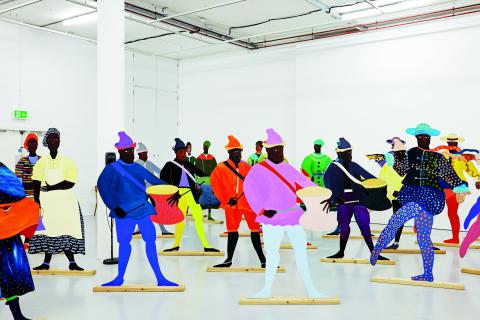This wonderful Cornish workshop and museum is dedicated to the legacy of studio pottery trailblazer Bernard Leach
Eye on the prize
Eye on the prize
6 Oct 2017
Hull will take centre stage this autumn when the Ferens Art Gallery hosts the Turner Prize. But while it is guaranteed to hit the headlines, does it actually make a difference? We find out more about contemporary art’s biggest event.
This September, the Turner Prize award and the prestigious follow-up exhibition will be staged in Hull, not – as for decades previously as a standalone show – but instead within the permanent collection of the Ferens Art Gallery. While bringing one of the world’s most prestigious art events to the north east affirms Hull’s success as 2017 UK City of Culture, the change also reflects the evolving face of the Turner Prize.
The prize was founded in 1984 by a group called The Patrons of New Art, designed to encourage wider public interest in contemporary British art. Naming the award after 19th-century painter JMW Turner nodded to the
power of debate to change opinion – many Victorian commentators expressed just the sort of “But is it art?” scorn about Turner that continues to greet Turner Prize nominees today.
The shortlist is created by a jury of four experts from across the industry, who this year included Dan Fox, writer and co-editor of Frieze magazine, and art critic Martin Herbert. Their role is to observe artists over the course of a year and choose those that have the biggest personal impact. “Sometimes an artist’s nomination will be unanimous, other times only one person will nominate them, but it doesn’t matter – it’s about having all those voices,” explains Linsey Young, curator of Contemporary British Art at Tate. Young was present at the jury’s discussion last year (though Tate’s role is solely as the mediator).
The nominated art often generates precisely the mix of celebration and disparagement the Turner Prize aims to promote. The 1995 triumph of visceral Britart shock trooper Damien Hirst is a classic example. An artist who sharply split opinions, Hirst himself noted in his acceptance speech: “It's amazing what you can do with an E in A-level Art, a twisted imagination and a chainsaw”. Hirst has gone on to be considered the world’s richest living practising artist.
The 1993 Turner Prize even generated controversy beyond the award itself. The K Foundation (founded by former members of the band KLF) offered an award of double the Turner Prize amount for the “worst British art” of the year - chosen from the Turner Prize list. As part of their award, they also burned £1m in banknotes on a remote Scottish island in a complicated protest against art world values. Coincidentally, Rachel Whiteread won both awards. But for art lovers, the most shocking event was when just weeks later London’s Tower Hamlets council decided to demolish her artwork House, a life-size cast of the interior of a Victorian terraced home. The man in charge of the demolition famously said: “It’s not art, it’s a lump of concrete.”
The work of this year’s quartet of nominees is surprising for its focus on social commentary, such as identity and belonging (Hurvin Anderson and Lubaina Himid), human occupation (Rosalind Nashashibi) or religion and ethics (Andrea Büttner).
Young doesn't think this is a coincidence. “I think perhaps this year the political content of the work reflects the landscape that is constantly in flux around us in the UK. Last year the artists were nominated just before the Brexit vote; the artists this year have had 12 months to think about what that means for them.”
It is also interesting that two nominees are above the previous upper age limit of 50. Young comments: “We don’t want the Turner to be a lifetime achievement award, that isn’t the point of it. It is about making a really exceptional body of work, but we want to recognise that that can happen at any time.”
Levels of public debate around the prize have dropped in recent years, but it remains the most famous date in the contemporary art calendar. “There will always be people who say art is rubbish and shouldn’t be in school curriculums and all those things, but I think the majority of people feel the need and see the importance for young people to be involved with creative endeavour and I think the Turner Prize keeps that in the public eye,” says Young.
She is in no doubt that this exposure (and the televised awards ceremony) has an impact. “It’s not so much about the prize, it’s about the artist. If they’re making brilliant, compelling work, it will be inspirational.”
The Turner Prize 2017 will be exhibited at Ferens Art Gallery until 7 January 2018. The awards ceremony will be broadcast by the BBC on 5 December 2017. hull2017.co.uk
Image: Lubaina Himid, Naming the Money, 2004. Installation view of Navigation Charts, Spike Island, Bristol 2017.
About the Author
The Arts Society
JOIN OUR MAILING LIST
Become an instant expert!
Find out more about the arts by becoming a Supporter of The Arts Society.
For just £20 a year you will receive invitations to exclusive member events and courses, special offers and concessions, our regular newsletter and our beautiful arts magazine, full of news, views, events and artist profiles.
FIND YOUR NEAREST SOCIETY
MORE FEATURES
Ever wanted to write a crime novel? As Britain’s annual crime writing festival opens, we uncover some top leads
It’s just 10 days until the Summer Olympic Games open in Paris. To mark the moment, Simon Inglis reveals how art and design play a key part in this, the world’s most spectacular multi-sport competition




